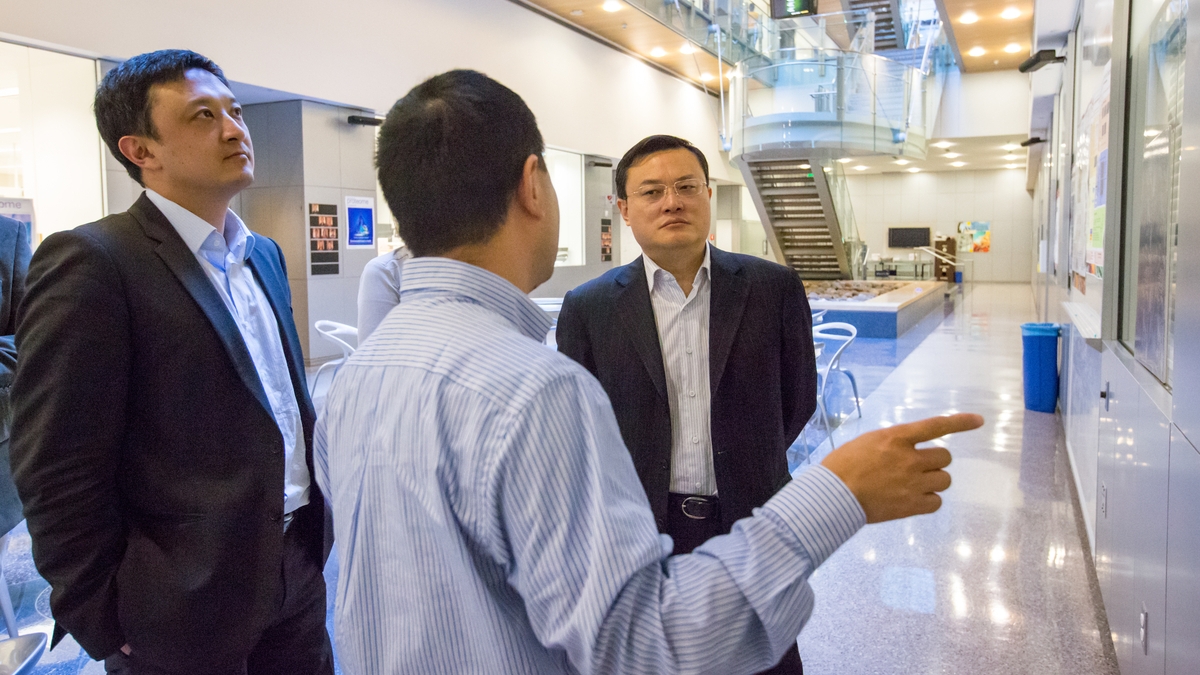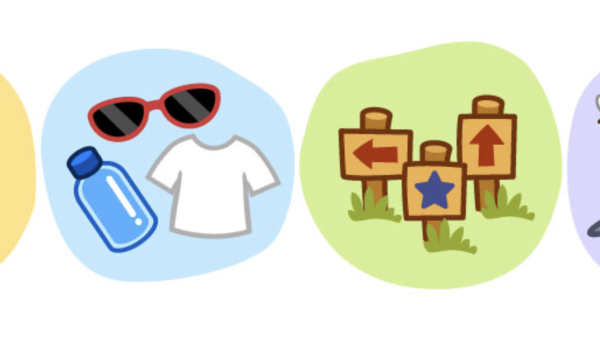ASU's Chinese partnerships broaden educational understanding

Shandong University international affairs director Nan Zou (left) and President Zhang Rong listen to associate professor Ji Qiu,of the Biodesign Institute's Center for Personalized Diagnostics during a tour of the ASU Biodesign Institute, on Tuesday, June 23, 2015. The schools are planning a variety of partnerships including a Biodesign Center in China.
The students quivered as they stood at the front of the classroom, before their peers, speaking out loud about their research projects.
It’s a scene that’s repeated a thousand times a day across American schools, but in China this was a dramatic change from the passive way those young people had been taught to learn.
And that cultural shift in education was being led by a Teresa Foulger, an Arizona State University professor who spent four weeks teaching Chinese students at Wuhan University in June.
Foulger, an associate professor in the Mary Lou Fulton Teachers College, was there to teach the graduate students how to publish their research in American journals.
As ASU explores another partnership with an institution in China, the implications are at once global and profoundly personal.
ASU has more than 20 relationships with Chinese universities, and is currently considering a faculty-exchange agreement with Wuhan University, which hosted four ASU professors this past summer.
The university’s international ties can lead to high-level research deals — like the recent partnership between ASU and Shandong University on a Biodesign Center in China.
But it’s the day-to-day personal interactions that create more compassionate, and efficient, teaching.
“I would never had known how different it was if I had just traveled there instead of being immersed in it,” Foulger said.
“I have so much more compassion for our foreign students now.”
A growing relationship
ASU’s relationships with Chinese institutions vary according to levels of engagement, from simple student exchanges to innovative research agreements.
Some of the notable programs include:
• ASU and Shandong University will partner on “bio-inspired” cancer and vaccine research, water and air purification systems and advanced explorations of nanotechnology. Shandong University’s Biodesign Center will be modeled after the ASU Biodesign Institute in Tempe, where researchers develop health care, sustainability and security programs.
• The W. P. Carey at Shanghai Executive MBA program is delivered in collaboration with Shanghai National Accounting Institute. That program trains top-level business and government officials. ASU’s business school has other programs in China, including a partnership with Motorola that was launched in 1998.
• The Confucius Institute at ASU was launched in 2007 in conjunction with Sichuan University and the Ministry of Education to promote language and culture. The institute provides curriculum to “Confucius classrooms” at 11 district schools around the Valley, holds summer camps, runs a faculty exchange and offers language lessons that are open to the public.
Angela Zhao, senior project manager in ASU’s Office of the President, said that that while a partnership with Wuhan has not been formalized, it would be a good match for ASU.
“It’s one of the top universities in China and has a very research-heavy background,” she said.
Zhao said that relationships are not without challenges. Even when there’s an agreement with another university, ASU has declined to admit students who are not proficient enough to study here.
“We still maintain our standards,” she said. “We need to be building partnerships and not just send students and faculty over.”
Moving past the "sit and get"
Foulger spent four weeks at Wuhan, teaching a class of students studying architecture, chemistry, nursing, linguistics, English literature and all kinds of engineering.
The Chinese students had no experience in interactive, Western-style learning.
They met in a classroom that had tiny, tightly packed desks which were bolted to the floor – not conducive to group work, which was itself a difficult concept for them to grasp.
“Chinese students are groomed to sit and listen. In teaching we call it ‘sit and get,’ ” said Foulger, who’s also the program coordinator of educational studies at the Teachers College.
At first, nobody raised their hands for discussion.
“Getting peer review — asking their colleagues to review their work before they send it to an editor — that level of vulnerability is very scary to them.”
She had to throw out the curriculum she developed and start over, encouraging the students to work together and speak up.
Still, Foulger said the Chinese are devoted to their educations and wanted to absorb everything she taught.
“They were enthralled by my stories of rejections, and stories about challenges with co-authors.”
And all of the students did everything she asked of them, no matter how uncomfortable it was.
“To get up in front of the classmates and give a two-minute ‘elevator pitch’ was the scariest thing for them. They were up there quivering,” she said.
Foulger believes she succeeded in helping the students toward their academic goals, and the experience changed her as well.
For example, until she worked on the Wuhan campus, she didn’t realize that the Chinese government blocks Google and YouTube. Foulger teaches online courses with Chinese students and will occasionally link to a YouTube video.
“They will have to pay someone to get to it illegally. They do know how to do that.”
Foulger said the experience was also transformational for her.
“I felt very respected, very admired for being from ASU and an American. For having been published.
“I understand where I sit globally as an associate professor at ASU.”
Wuhan University considered the ASU professors’ visit a success, according to Tianyi Wang, the official in charge of Wuhan’s graduate school.
Afterward, the university surveyed the students, and found that three-quarters believed the ASU professors had improved their academic writing ability. More than half said they had a clear idea of how to publish in an American journal, according to the survey, and nearly all of them said they would take the course again.
“It told us a delightful result,” Wang said.
More Science and technology

Advanced packaging the next big thing in semiconductors — and no, we're not talking about boxes
Microchips are hot. The tiny bits of silicon are integral to 21st-century life because they power the smartphones we rely on,…

Securing the wireless spectrum
The number of devices using wireless communications networks for telephone calls, texting, data and more has grown from 336…

New interactive game educates children on heat safety
Ask A Biologist, a long-running K–12 educational outreach effort by the School of Life Sciences at Arizona State University, has…